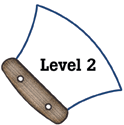
Alaska Science
Key Element C1
A student who meets the content standard should know how the words “fact,” “observation,” “concept,” “principle,” “law,” and “theory” are generally used in the scientific community.
 |
Alaska Science A student who meets the content standard should know how the words “fact,” “observation,” “concept,” “principle,” “law,” and “theory” are generally used in the scientific community. |
|
Performance Standard Level 2, Ages 8–10
|
|
|
|
Sample Assessment Ideas
|
|
|
Expanded Sample Assessment Idea
|
|
Procedure Students will:
Reflection and Revision
|
Levels of Performance |
||
|
Stage 4 |
Student observations are correct, complete, and appropriate, and contain elaboration, extension, and evidence of higher-order thinking and relevant knowledge. There is no evidence of misconceptions. Minor errors do not necessarily lower the score. | ||
|
Stage 3
|
Student observations are correct, complete, and appropriate; although minor inaccuracies are present. There may be limited evidence of elaboration, extension, higher-order thinking, and relevant knowledge; or there may be significant evidence of these traits, but other flaws (e.g. inaccuracies, omissions, inappropriateness) are evident. | ||
|
Stage 2
|
Student observations are inaccurate, incomplete or inappropriate, although may contain some elements of proficient work. There is little, if any, evidence of elaboration, extension, higher-order thinking or relevant knowledge. There may be evidence of significant misconceptions. | ||
|
Stage 1
|
Student work, although it may be on topic, fails to address the question, or addresses the question in a very limited way. There is evidence of serious misconceptions. | ||
Standards Cross-References
|
||
|
National Science Education Standards Scientists develop explanations using observations (evidence) and what they already know about the world (scientific knowledge). Good explanations are based on evidence from investigations. (Page 123) Communicate scientific procedures and explanations. With practice, students, should become competent at communicating experimental methods, and following instructions, describing observations, summarizing the results of other groups, and telling other students about investigations and explanations. (Page 148) Scientific explanations emphasize evidence, have logically consistent arguments, and use scientific principles, models, and theories. The scientific community accepts and uses such explanations until displaced by better scientific ones. When such displacement occurs, science advances. (Page 148) |
Benchmarks Buttress their statements with facts found in books, articles, and databases and identify the sources used and expect others to do the same. (Page 299) |
|
Table of Contents | Return to Alaska Native Knowledge Network